Northern Flicker: Field Guide, Pictures, Habitat & Info
Last Updated on
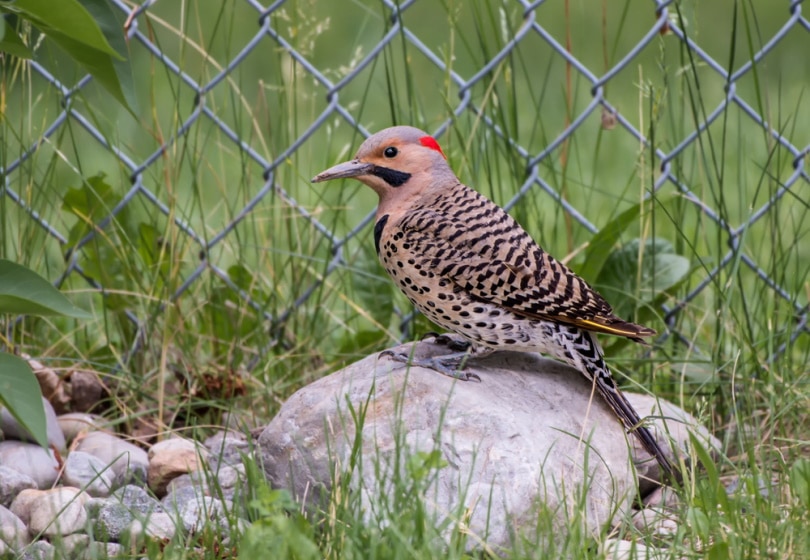
The Northern flicker (Colaptes auratus) is a common medium-sized woodpecker that frequents the majority of North and Central America. Unlike most woodpeckers, the Northern flicker is a ground forager and is often found walking along the ground in open woodlands and forest edges where they forage for ants. Northern flickers are found in red-shafted (cafer group) and yellow-shafted (auratus group) varieties, with the two subspecies occasionally hybridizing to produce the Intergrade Northern flicker. Keep reading to learn more about this fascinating woodpecker and how you can find and attract them to your backyard.

Quick Facts About the Northern Flicker
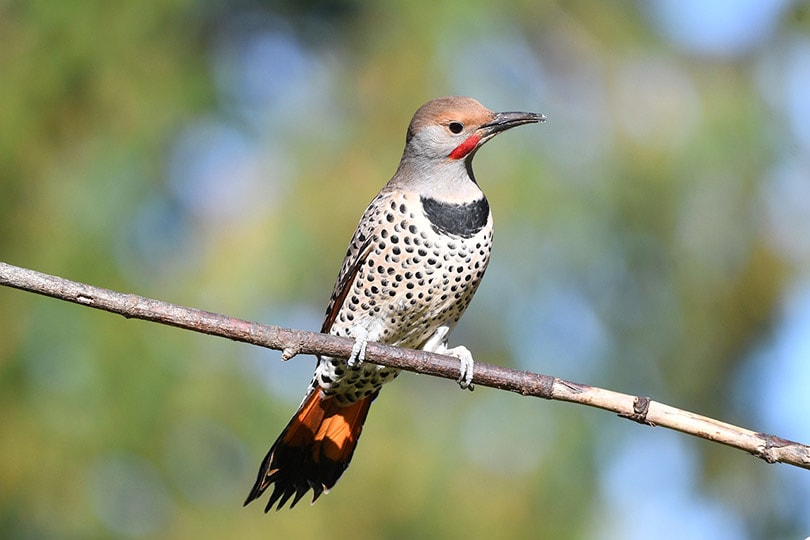
| Habitat | Open woodlands |
| Diet | Insects |
| Behavior | Ground forager |
| Nesting | Cavity |
| Conservation | Low Concern |
| Scientific name | Colaptes auratus |
| Lifespan | 6–9 years |
General Description
Northern flickers are generally 30 to 35 centimeters (cm) in length with a wingspan of approximately 54.1 cm. Their backs are dusty brown with characteristic black barring and their light tan breasts sport an interesting pattern of black crescents. Their rumps are a bright white and their heads are tan with a gray crown, black mustache, and red nape. In the eastern ranges of their habitat, the males have bright yellow plumage under their wings and tails, forming the yellow-shafted Northern flicker.
In the west, however, the males sport bright red plumage, making up the red-shafted subspecies. The females of both subspecies resemble the males but lack their black “mustaches.” The ranges of these two subspecies overlap along the Great Plains, where they often hybridize to produce the Intergrade Northern flicker.

Range, Habitat, Behavior, Diet, & Nesting
Range
The Northern flicker thrives in an extensive range, found in areas as far north as Alaska to the southern reaches of the Nicaraguan highlands. Some of the northernmost birds also migrate to areas as far south as Mexico and the islands of Grand Cayman and Cuba.
Habitat
Northern flickers are generally found in wooded areas with dead trees, terrestrial forests, and temperate rainforests. However, they also frequent forest edges, open clearings, agricultural lands, burnt areas, and residential areas.
Behavior
Unlike typical woodpeckers, Northern flickers prefer to forage on the ground alongside other birds such as sparrows and blackbirds. On occasion, they will perch on thin branches to reach tasty seeds and fruits, although they prefer to eat insects. Northern flickers can be identified by their characteristic flight, which is deeply undulating and consists of periods of flapping and gliding.
During the breeding season, rival males may face off in a “fencing duel” while prospective mates look on. They incline their heads and aggressively point their bills toward each other, often pecking at their opponents. A more aggressive display consists of the two males facing each other with their bills pointed upwards. This is generally accompanied by synchronized head-bobbing, which draws a loop or figure-eight pattern in the air. In addition, Northern flickers may make a rhythmic “wicka wicka” call and spread their tail feathers during the territorial display.
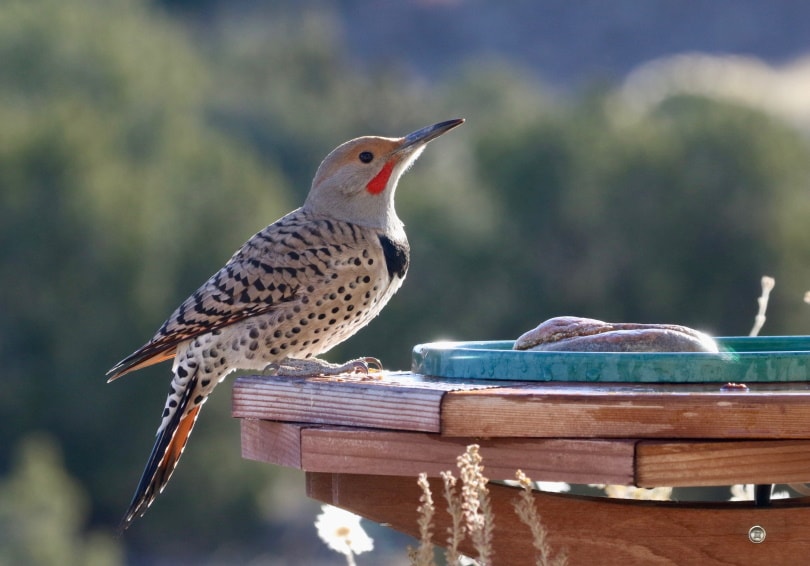
Diet
The Northern flicker is an omnivore, which means it eats both plant and animal matter. Their primary diet consists of ants and other insects such as grasshoppers, wasps, termites, beetles, aphids, caterpillars, termites, and spiders. Northern flickers prefer to forage on the ground, using their beaks and 2-inch long barred tongues to retrieve nutritious ant larvae from underground. In the colder months, Northern flickers readily eat poison ivy, sumac, hackberries, weed seeds, acorns, wild cherries, grapes, elderberries, sunflower seeds, and other nut kernels.
Nesting
The Northern flicker is a cavity nester that breeds from February through July, raising one or two broods annually. They build their nests in existing tree cavities or by excavating cavities in dead or diseased tree trunks and branches. However, Northern flickers have also been observed nesting in telephone poles, birdhouses, and nesting boxes.
Nests are generally built 6 to 15 feet off the ground. However, on rare occasions, they may be built over 100 feet high. The male and female Northern flicker help excavate the nesting cavity, which is 3 inches in diameter and about 13–16 inches deep. The cavity is kept bare except for a bed of wood chips on which a clutch of 5–12 glossy white eggs is laid. The eggs are incubated by both the male and female Northern flicker that take turns nurturing the eggs for 11–13 days. Once the nestlings are about 17 days old, they begin clinging to the cavity walls rather than laying on the floor.

How to Find the Northern Flicker: Birdwatching Tips
What to Listen For
Northern flickers sing a 7 or 8-second song that sounds like a rolling rattle, undulating in volume throughout. During flight, they may also sing a squeaky song that sounds like “flick-a flick-a flick-a.” When Northern flickers are together, they call to each other with a single loud note that lasts for about half a second and sounds like “klee-yer.” Other calls include a quiet “wick-a wick-a wick-a” and a rapid, rhythmic drumming sound produced by hammering against trees and metal objects as a form of territorial defense.
What to Look For
Northern flickers avoid deep and dense forests because they prefer to forage on the ground. Instead, they prefer woodland edges where the supply of nutritious ants, their favorite snack, is plentiful. To find a Northern flicker, look for collections of dead and diseased trees and natural tree cavities where they build their nests. Favored residences include cottonwood, aspen, willow, and pine trees. Sometimes, you don’t need to look up to find this vibrant woodpecker. Instead, look down to see them hopping along the ground in search of insects.
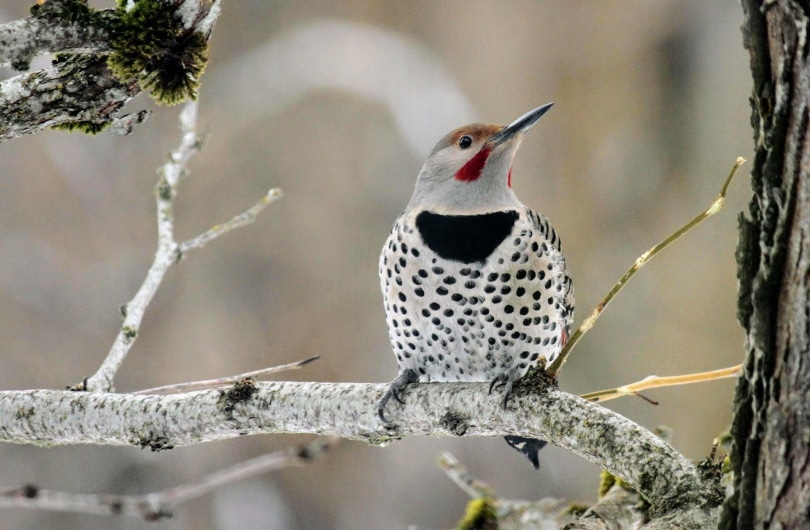
When to Look
The best time to look for Northern flickers is during spring and early summer. At this time, they begin to establish their territories and form breeding pairs, which is when they are most active.
Attracting Northern Flickers to Your Backyard: Tips & Tricks
- Install a nesting box before the mating season to attract a breeding pair to your backyard.
- Attach a guard to the nesting box to keep predators such as raccoons, squirrels, snakes, and birds of prey from raiding the eggs and young.
- Northern flickers generally don’t visit hanging bird feeders as they tend to forage on the ground. However, installing a ground feeder or scattering snacks such as suet, sunflower seeds, nuts, and berries can help attract Northern flickers to your backyard.
- Northern flickers frequent bird baths, so having a similar water source in your backyard can attract them.
- Plant native fruit-bearing trees and shrubs.
- Interestingly, Northern flickers are big fans of peanut butter. You can easily attract them by making an easy DIY feeder by slathering a pinecone with peanut butter and rolling it in a variety of nuts.
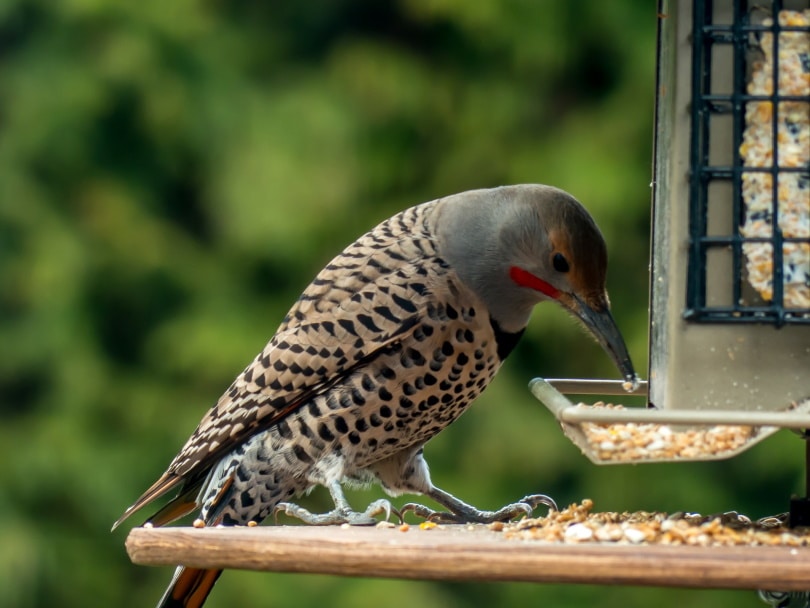
Northern Flicker Conservation: Is This Bird Threatened?
Northern flickers are common birds with an estimated global breeding population of about 12 million individuals. According to the North American Breeding Bird Survey, the Northern flicker population has decreased by an estimated 1.2% per year between 1966 and 2019. However, Northern flickers are of low conservation concern with a continental concern score of 9 out of 20. As a migratory North American bird, Northern flickers are protected by the U.S. Migratory Bird Act.

Conclusion
The Northern flicker is a fascinating member of the woodpecker family that has a tremendously positive impact on its ecosystem. The birds help control the population of ants, invertebrates, and destructive aphids. Additionally, Northern flickers excavate nests that are later reused by other birds and squirrels. This vibrant woodpecker is a welcome visitor in backyards all across North and Central America and is relatively simple to attract. They are also easily recognizable with their flashy white rumps, vibrant plumage, and characteristic song that makes them a favorite amongst birdwatchers.
Featured Image Credit: FotoRequest, Shutterstock
About the Author Laura Guziczek
Laura Guziczek is from New York City and an aerospace engineer by day, freelance writer by night. Although she is always moving around, Laura is currently based on Florida's sunny Space Coast, where she attends graduate school. Her passions and hobbies include astrodynamics, rocketry, spaceflight, planetary science, cooking, music, and art, making her a great fit here at OpticsMag! When she's not working, you can frequently find her traveling, honing her cooking skills, thinking about space too much, and hanging out with her friends and dogs.
Related Articles:
10 Types of Hummingbirds in Arkansas (With Pictures)
8 Types of Hummingbirds in Nebraska (With Pictures)
5 Types of Hummingbirds in Idaho (With Pictures)
3 Types of Hummingbirds in Mississippi (With Pictures)
8 Types of Hummingbirds in Kansas (With Pictures)
5 Types of Hummingbirds in West Virginia (With Pictures)
5 Types of Hummingbirds in Ohio (With Pictures)
Where Do Nuthatches Nest? Nuthatch Nesting Habits Explained
